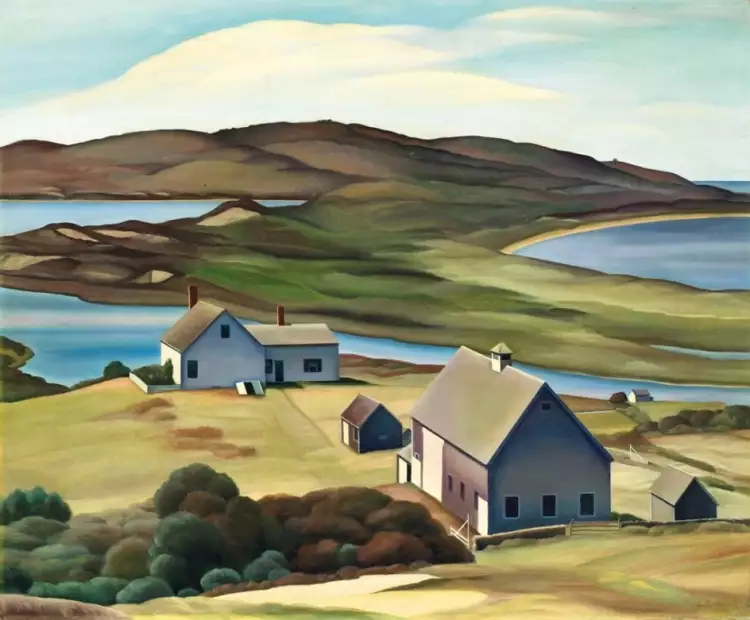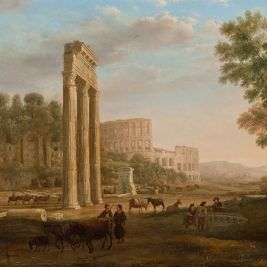
Regionalism is an American art movement that celebrates the beauty of simple provincial life
Regionalism is an art movement in American painting and graphics of the 1930s-40s, characterized by a realistic depiction of everyday scenes from the lives of rural inhabitants and small provincial towns. The primary goal of regionalism adherents was to create authentic American art based on the traditions of academicism and neoclassicism.
 Regionalism. Grant Wood. American Gothic, 1930
Regionalism. Grant Wood. American Gothic, 1930
Regionalism, in its artistic direction, shares many similarities with social realism; in both cases, the protagonists of the works are ordinary people. However, regionalists portrayed their surroundings in a patriotic and romantic spirit, rather than from a critical perspective as is common with social realists.
 Regionalism. John Steuart Curry. Baptism in Kansas, 1928
Regionalism. John Steuart Curry. Baptism in Kansas, 1928
History of Regionalism
Regionalism in American painting emerged during the Great Depression in the early 1930s, when the country experienced a severe economic and social crisis. However, the prerequisites for the emergence of this movement appeared several decades earlier.
 Regionalism. Grant Wood. Fall Plowing, 1931
Regionalism. Grant Wood. Fall Plowing, 1931
The early 20th century in the world of visual arts was marked by the emergence of numerous revolutionary avant-garde movements. Radical artistic ideas found embodiment in new styles that boldly challenged conservative academism:
- Fauvism.
- Dadaism.
- Cubism.
- Suprematism.
- Surrealism.
- Unitarism.
- Expressionism.
- Futurism.
 Regionalism. Edna Reindel. Farm on Martha's Vineyard, 1931
Regionalism. Edna Reindel. Farm on Martha's Vineyard, 1931
But the center of revolutionary changes in those years was Europe, while conservative cultural norms continued to dominate in the USA. Most American artists refused to embrace the tenets of avant-gardism; they called on their colleagues to join forces to create their own art based on traditional American values.
 Regionalism. Grant Wood. Daughters of Revolution, 1932
Regionalism. Grant Wood. Daughters of Revolution, 1932
The onset of the Great Depression served as a powerful impetus to realize the idea of returning to the ideals of authentic America. Against the backdrop of universal uncertainty about the future, the paintings of regionalists depicting the tranquil life of the provinces were warmly received by the public.
 Regionalism. Thomas Hart Benton. Persephone, 1939
Regionalism. Thomas Hart Benton. Persephone, 1939
The 1930 exhibition at the Art Institute of Chicago marked the triumphant emergence of regionalism in American painting. At this event, in addition to works by dozens of other authors, the works of three main ideologists of the new movement were exhibited:
- Grant Wood.
- Thomas Hart Benton.
- John Steuart Curry.
 Regionalism. John Steuart Curry. Tragic Prelude, 1942
Regionalism. John Steuart Curry. Tragic Prelude, 1942
The highlight of the exhibition was Grant Wood's painting "American Gothic." Critics raved about its merits, and spectators flocked to the hall to see authentic American art firsthand. High praise also befell the works of the other two regionalist artists.
 Regionalism. John Rogers Cox. Gray and Gold, 1942
Regionalism. John Rogers Cox. Gray and Gold, 1942
From this moment, regionalism gained immense popularity in the USA. The patriotic paintings of its followers helped ordinary Americans regain faith in themselves and in the unique distinctiveness of their homeland. Riding the wave of success, Grant Wood even founded an art colony called Stone City in his home state of Iowa, where aspiring painters could receive practical instruction in the fundamentals of visual arts almost for free. However, due to a lack of funding, this school lasted only 2 years and was then closed.
 Regionalism. Andrew Wyeth. Winter 1946, 1946
Regionalism. Andrew Wyeth. Winter 1946, 1946
Throughout the 1930s, regionalism remained in the forefront of American art. However, with the onset of World War II, the public gradually lost interest in it as the bloody events led to a fundamental reassessment of values in American society.
 Regionalism. Thomas Hart Benton. Achelous and Hercules, 1947
Regionalism. Thomas Hart Benton. Achelous and Hercules, 1947
In 1942, Wood passed away, and in 1946, Curry followed him into the afterlife. Benton, the sole survivor, withdrew from active public life and began leading a quiet, measured existence, working in his own studio. In the United States, a new era in visual arts emerged — abstract expressionism took center stage.
 Regionalism. Andrew Wyeth. Christina's World, 1948
Regionalism. Andrew Wyeth. Christina's World, 1948
The Most Famous Regionalist Artists
Among the numerous worthy representatives of this unique movement in American painting, four iconic names stand out. Among the most well-known regionalist artists are:
- Grant Wood - the author of the most famous painting in the regionalist style. His idol in painting was the great Dutch master Jan van Eyck, from whom Wood borrowed the excellent precision of his artistic images.
- Thomas Hart Benton - a painter who earned fame not only for his paintings but also for creating a vast number of colorful murals. Ironically, Benton, a vehement opponent of avant-garde art, became the teacher of one of the world's best abstract expressionists - Jackson Pollock.
- John Steuart Curry - an artist who dedicated his life to celebrating the beauty of his home state of Kansas and the lives of simple farmers. In addition to numerous paintings, Curry created many engravings, posters, and book illustrations in the regionalist style.
- Andrew Wyeth - a painter who lived for over 90 years, quickly earning recognition from critics and the public. Wyeth became the first American artist awarded one of the two highest honors in the United States for civilians - the Presidential Medal of Freedom.
 Regionalism. Thomas Hart Benton. Joplin at the Turn of the Century, 1972
Regionalism. Thomas Hart Benton. Joplin at the Turn of the Century, 1972
Regionalism remains an important part of American visual arts. This movement continues to have many supporters today, and paintings by outstanding masters are eagerly purchased by art connoisseurs at auctions.
 François Boucher - the frivolous artist of the French king: biography and best paintings
François Boucher - the frivolous artist of the French king: biography and best paintings  German Porcelain: History of Creation and Development
German Porcelain: History of Creation and Development  Surrealism and Abstract Gradients: Design Trends Shaping 2024
Surrealism and Abstract Gradients: Design Trends Shaping 2024  Marine landscape is the most romantic genre of visual art: history, artists, and paintings
Marine landscape is the most romantic genre of visual art: history, artists, and paintings  Top 10 Most Iconic Sculptors in the World
Top 10 Most Iconic Sculptors in the World  Michelangelo - the greatest sculptor in the world: biography and works of the Italian artis
Michelangelo - the greatest sculptor in the world: biography and works of the Italian artis  The painting " The Whirlwind" by Filipp Andreevich Malyavin is an inspiring hymn to the beauty and strength of character of Russian peasant women
The painting " The Whirlwind" by Filipp Andreevich Malyavin is an inspiring hymn to the beauty and strength of character of Russian peasant women  Live Fine and Applied Аrt Auction No.8 of the Antiqon trading platform
Live Fine and Applied Аrt Auction No.8 of the Antiqon trading platform  Illuminating the Past: The Rise of Vintage Lighting in Modern Decor
Illuminating the Past: The Rise of Vintage Lighting in Modern Decor  The most famous representatives of French classicism in painting
The most famous representatives of French classicism in painting